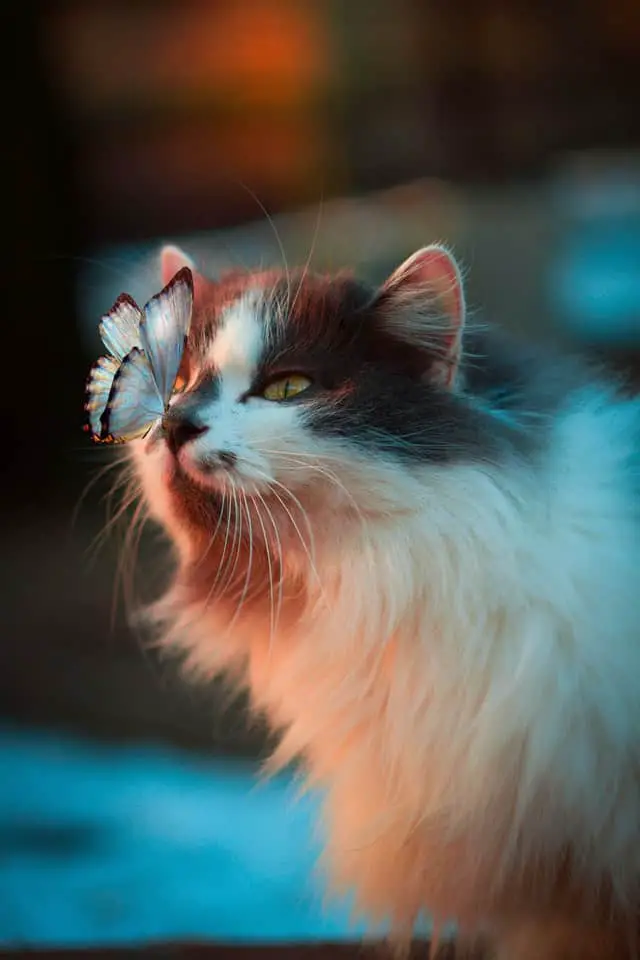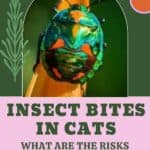
Pats are very curious. And precisely because of this, they are subject to some danger. What to do in case of insect bites in cats?
An old saying, curiosity killed the cat, actually has a certain element of truth. Cats are nosy creatures, sniffing for something interesting. They study, search, explore, but above all they hunt: their predatory instinct is very strong, and leads them to the constant search for something to prey on. And of course, if they find something interesting, they tend to eat it or bite it, or even just put it in their mouths. Because felines find insects interesting, they study them by sniffing them, and if they put their noses where they shouldn’t, they could find themselves with some sting or bite, which could even be fatal.
Insects and cats: a stormy relationship
Insects are affected by the intrusion of nosy cats into their territory, so they sting the nearest part of the body, with eyes, ears and paws as easy targets. When a cat walks up a hill covered in ants or disturbs a wasp’s nest or a bee hive, these insects can swarm and sting the cat’s entire body. Spiders are solitary, but even a single spider bite can be serious.
Stings from bees, wasps and hornets and bites from ants and spiders can all cause problems for cats. Insect venom causes problems ranging from mild irritation to deadly shock. As loving pet owners, we must try to minimize the reaction by taking prompt action. However, we keep in mind that although first aid is started at home, the most serious cases require immediate medical attention.
Here is what we can do when in case of insect bites in cats:
- Be prepared to acknowledge that our cat has been bitten or stung. If the cat suddenly puts a paw in its face, chews its paws, or begins to swell in any area of the body, consider the possibility of an insect bite.
- Identify the insect. We quickly search the area for both flying and crawling insects. Since a spider is difficult to identify and can be poisonous, we try to catch it if possible.
- In the case of bee stings, we look for a sting. Bees are the only insects that leave their stings in their victims. These abandoned stingers continue to secrete venom, so removing them reduces the amount of toxin injected into the cat’s body. If the sting is still attached to the cat, remove it by scraping with a credit card or plastic card on the cat’s fur, and leafing through it. We don’t use tweezers, which could squeeze more venom out of the sting bag. Fortunately, other flying insects (wasps, hornets) do not leave a sting behind.
- We treat the area of the bite or sting. Prepare a thick paste of baking soda and water and apply it to the puncture site. If the cat has suffered multiple stings or bites, a soothing oatmeal bath is the way to go.
- Minimize swelling. Applying an ice pack to the affected area for 10 minutes helps reduce swelling. A sachet of frozen peas serves as a handy ice pack for single bites. A cooled towel works even better, for larger areas.
- Preventing allergic reactions, administering a dose of an oral antihistamine (such as diphenhydramine) can minimize the reaction and itching. We first consult our vet for the correct dosage.
- Reducing the trauma of scratching is very helpful in the onset of the condition. We use a cone, if our cat continues to lick or scratch the wound resulting from the bite or sting. Constant scratching delays healing, and can cause infections.
- Maintain constant hydration and food intake. We give the cat fresh water to drink. Cats that are bitten in the mouth may have difficulty eating, so we feed them wet food. Dry food softened with water is less likely to upset her gastrointestinal tract than canned food.
Insects that can sting / bite our cat
The most likely insects for our cat to meet are the following, each with specific characteristics and different degrees of danger.
Fleas
Fleas are bloodthirsty insects that jump on the bodies of our pets, and grow on the surface of the skin. The head, neck, groin, perineum (area around the anus), and base of the tail are common locations where fleas congregate, bite, and irritate the skin. As a result, our pet will lick, chew or scratch in an attempt to relieve irritation. Skin lesions from flea bites may have swelling, redness, hair loss, scabs, and oozing.
Ticks
Ticks opportunistically cling to the fur of animals that graze a blade of grass, leaves, branches, earth or other environmental surfaces. Ticks are slow-moving creatures that crawl across the surface of the skin, until they find a suitable location to bite through the layers of the skin to take a blood meal.
The face, head, ears and sides of the body (hips) and limbs are common sites where ticks are discovered on cats and dogs. These insects can go unnoticed until they feed and grow in size. Redness can occur around the tick bite; swelling and scabs can then occur after the tick is removed or falls off.
Mites
Mites (such as mange) are microscopic insects that burrow deep into the layers of the skin to feed and live. Mange skin lesions can occur throughout the body, but the armpits, groin, ear margins, and areas with minimal hair (elbows, etc.) are most commonly affected. Swelling, redness, hair loss, scabs, oozing, or other injuries may occur, secondary to mange.
Mosquitoes
Pets experience the sensation of a mosquito bite penetrating the skin, so sudden licking, chewing, or scratching directly at the bite site commonly occurs. All surfaces of the body are prone to mosquito bites, but larger surface areas (back, hips, etc.) of the body provide large areas to bite. Swelling, redness and hives can be seen after the mosquito bite. While the itch may last for minutes or hours, it probably won’t have long-term effects.
Bees, hornets and wasps
Like mosquitoes, a bee, hornet, or wasp sting tends to localize to the point of entry into the skin and can occur anywhere on the body. However, the sting of these insects causes significant pain that can lead to sudden vocalization, lameness, itching, or other signs. Additionally, their venom creates a significant inflammatory response leading to swelling, redness, hives, and more systemic signs such as vomiting, diarrhea, tripping, collapse, and low blood pressure (hypotension) in sensitive pets.
Ants
Ant bites also cause localized pain and swelling, but they typically have no significant effect on the whole body. Ants crawl over animals at the point of contact between a part of the body and the ground, so standing pets are bitten while standing and animals that relax can be bitten anywhere on the body that touches the floor. Itching, redness, and lameness are most commonly associated with ant bites on pets.
Flies
Like fleas and ants, fly bites tend to cause pain and swelling, but they typically don’t have significant effects on the whole body. Newborn, geriatric, and mobility impaired pets are more prone to the consequences of fly bites, including itching and redness. Flies can deposit their eggs on our pet’s skin, especially in open sores. Within days, the eggs hatch into larvae that crawl to the surface or break within deeper layers of the skin and lead to swelling and secondary infection (bacteria, etc.).
When to worry about an insect bite

Like some people, many cats are hypersensitive (very allergic) to insect stings or bites. The degree of reaction varies depending on the cat’s immune system and the type of insect. Allergic reactions usually occur within 20 minutes of the bite, but can be delayed for hours, so careful monitoring is crucial. More severe reactions (anaphylaxis) can also be fatal, so quick action is vital.
We take the cat to the vet for an emergency check- up at the first sign of any (or more) of these symptoms:
- Severe swelling around the head and neck (enough to compromise breathing). The bite need not have occurred in these areas.
- Hives on any part of the body. The marks may appear as bumps under the skin that lift the hair or as red bumps on hairless areas such as the belly. Hives are very itchy, so your cat may roll around in the grass or on the floor in an attempt to scratch hard-to-reach spots .
- Difficulty breathing or wheezing. Cats don’t usually breathe through their mouths, so if the cat starts panting, let’s call the vet.
- Excessive drooling, caused by swelling in the throat and difficulty swallowing saliva.
- Agitation and anxiety. Some cats get agitated due to itching and difficulty in breathing. In addition, insect venom can affect the nervous system.
- Mild vomiting and loose stools can also indicate problems.
- Dizziness or disorientation: if the cat is not alert or stumbles.
- Convulsions.
Medical treatment can save our cat’s life and aims to reduce the allergic reaction and prevent shock. In addition to antihistamines, the vet can give the cat corticosteroids or epinephrine, but also intravenous fluids to stabilize the cat and oxygen to help with breathing.
The goal here is not to stifle our cat’s curious nature, but to be prepared for the consequences. This means that we must act quickly in the event of cat insect bites or bites.






